



Minimising Pain in Farm Animals
FRANCE - Recently, the French National Institute for Agricultural Research appointed an expert committee to review the issue of pain in food-producing farm animals. To minimise pain, the authors developed a ‘3S’ approach accounting for ‘Suppress, Substitute and Soothe’ by analogy with the ‘3Rs’ approach of ‘Reduction, Re?nement and Replacement’ applied in the context of animal experimentation.Thus, when addressing the matter of pain, the following steps and solutions could be assessed, in the light of their feasibility (technical constraints, logistics and regulations), acceptability (societal and ?nancial aspects) and availability.
The ?rst solution is to suppress any source of pain that brings no obvious advantage to the animals or the producers, as well as sources of pain for which potential bene?ts are largely exceeded by the negative effects. For instance, tail docking of cattle has recently been eliminated. Genetic selection on the basis of resistance criteria (as e.g. for lameness in cattle and poultry) or reduction of undesirable traits (e.g. boar taint in pigs) may also reduce painful conditions or procedures.
The second solution is to substitute a technique causing pain by another less-painful method. For example, if dehorning cattle is unavoidable, it is preferable to perform it at a very young age, cauterising the horn bud. Animal management and constraint systems should be designed to reduce the risk for injury and bruising.
Lastly, in situations where pain is known to be present, because of animal management procedures such as dehorning or castration, or because of pathology, for example lameness, systemic or local pharmacological treatments should be used to soothe pain. These treatments should take into account the duration of pain, which, in the case of some management procedures or diseases, may persist for longer periods.
The administration of pain medication may require the intervention of veterinarians, but exemptions exist where breeders are allowed to use local anaesthesia (e.g. castration and dehorning in Switzerland). Extension of such exemptions, national or European legislation on pain management, or the introduction of animal welfare codes by retailers into their meat products may help further developments.
In addition, veterinarians and farmers should be given the necessary tools and information to take into account animal pain in their management decisions.
TheCattleSite News Desk


